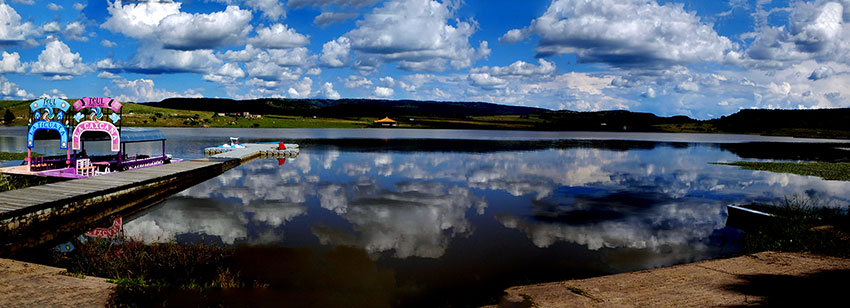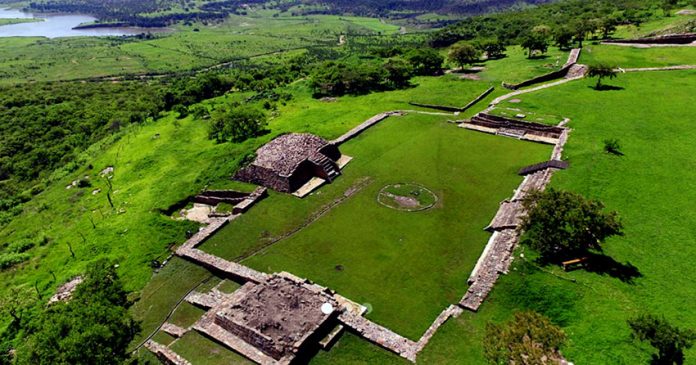Teúl de González Ortega, located near the south end of the state of Zacatecas, is one of Mexico’s most beautiful and interesting towns: a Pueblo Mágico (Magical Town) truly deserving of the name, conveniently located right next to an amazing archaeological site.
“Let’s go visit the Cerro de Teúl,” I suggested to friends in Guadalajara, where I live.
I got a lot of blank stares… and then: “Where is it?”
Next thing I knew, there I was, The Old Gringo, telling my Mexican friends about one of their own treasures.

But perhaps their lack of knowledge is understandable: the Cerro de Teúl archaeological site — located where a pre-Hispanic city was built on a mountain — only opened to the public in 2018 after a decade of excavation. Researchers say it has at least 17 — if not 19 — centuries of history.
“It’s a two-hour drive from Guadalajara, straight north along an excellent highway, through one of the more picturesque canyons in Mexico, la Barranca de San Cristóbal, and right now (October) the roadside is festooned with vast stretches of wildflowers.”
Inevitably, the next question was: “Is it safe?”
This question is now in vogue any time you mention a place that seems “far away.” Conventional wisdom says that “far away” is automatically dangerous and definitely populated by “mala gente” (bad people).
“My contacts in [the town of] Teúl [a historian and an archaeologist] both say it’s perfectly safe.”

The following Saturday found a group of my friends winding our way beneath high, red cliffs, overlooking deep valleys filled with billowy white clouds of morning fog. With such glorious views, the two hours passed quickly and suddenly the Cerro de Teúl, a great peak shaped like a giant sombrero, loomed above us, so stately and imposing that even the notorious conquistador Nuño Beltrán de Guzmán remarked upon its grandeur.
Two minutes after entering the Magical Town of Teúl de González Ortega, we reached the base of this little mountain and the site’s visitors center, where we were met Teúl’s very own chronicler, Professor Ezekiel Ávila, as well as archaeologist Peter Jiménez.
Jiménez informed us that he would be completely superfluous on our tour of the ruins because the site was a pioneer in the development of an ingenious app that was going to guide us along our 1.8-km circuit, using narration, animations, videos and augmented reality — an interactive experience that combines the real world and computer-generated content. All we had to do was download the free Cerro de Teul app from the Google Play store.
The app is unfortunately only for Android, so if you have an iPhone, you’d better hire a human guide.

“Now, if any member of a group is disabled,” mentioned Jiménez, “he or she can relax in the visitors’ center and — wearing a virtual reality headset — enjoy a complete guided tour of the ruins. It’s so realistic, some people actually get a little dizzy while virtually walking up the steep hillside.”
A few minutes later, we were huffing and puffing up that same steep slope, grasshoppers jumping out of our way with every step. Because we had snapped a picture of the first explanatory sign on the trail, our smartphones had been activated and they were now explaining to us that the Cerro de Teúl is one of the richest archaeological sites in Mexico because it was continuously occupied for nearly 2,000 years by peoples who were never conquered by the Mexica.
We learned that a great city had covered every inch of the hill we were climbing, that it was one of the first industrial zones of the continent, where they manufactured products made of copper and ceramics. Indeed, it is on this hill that they discovered the oldest copper-smelting furnace ever found in pre-Hispanic Mexico, used between A.D. 900 and 1200 and fired by corn cobs.
Then, after proceeding up steep stairs built centuries ago to a long, flat area bordered by two pyramids and offering a magnificent view of distant mountains, our omniscient app, (with a little help from Peter Jiménez) explained that we’d reached an ancient ceremonial center, where rituals were held — especially during the spring equinox — to reenact, so to speak, the creation of the world.

This plaza would be crowded with people, who were told that, “in the beginning, there was darkness and there was water and there was a serpent… Then the gods created fire, and the sun appeared in the east, where there was a sacred mountain. And the sun climbed the mountain, and this was the first sunrise.”
Within the bounds of the plaza, archaeologists found an undulating canal which represents the serpent. They also found the remains of many ancient bonfires. The pyramid, of course, represented the sacred mountain. Even today, if you come during the spring equinox, you will see the sun rise directly behind it.
A few minutes walk from the plaza took us to a sunken patio, as archaeologists call it, where people used to dance, eat and drink.
Beneath this patio, the app told us, archaeologists found some 60 skeletons, apparently the bodies of famous persons, who were honored by being buried in this sacred spot.

“These people,” we learned, “typically had artificially flattened heads and teeth filed to sharp points.”
Then, the app asked us, “Would you like to take a selfie with one of the skeletons?”
Well I couldn’t resist, and now — thanks to augmented reality technology — I have a photo of myself hobnobbing with a 1,000-year-old celeb.
Further up the hill, we came to a well-preserved ball court where we got to see 1,000-year-old statues of two ballplayers. One of them is nearly two meters tall and was deliberately sculpted without a head, perhaps confirming the old belief about the ancient ballgames that the captain of the winning team was honored by decapitation.

At the highest point in our tour, we came to one of seven shaft tombs found on this cerro, all of them approximately 2,000 years old. This was where the tour ended.
A self-guided walk through the ruins takes about two hours, leaving you plenty of time to wander through the pretty streets of the Pueblo Mágico of Teúl and work up an appetite.
After being thoroughly charmed by the town’s arches, balconies and clean, quaint streets, we were now ravenously hungry, so drove down to a adorable little lake (Presa la Ticuata) just south of town and hopped aboard a floating restaurant.
Actually “floating dinner table” might be a better description. The boat was long and narrow, with just enough room for the table and seated diners, which meant we were kept plenty busy before, during and after the meal, passing place settings, food and drink up and down the line.

Our delicious chamorro al vapor (steamed pork hock) dinner included Teúl’s culinary specialty: gorditas, served on oak-leaf “plates.” By the time we had finished eating we had toured the lake and strolled around several picturesque spots on its shores.
Finally, you can’t escape from Teúl without a visit to Don Aurelio’s Distillery, where you quickly discover that first-class tequila can indeed be produced in the state of Zacatecas… as long as you label it “mezcal.”
After describing a full day in Teúl, I have to admit that maybe there is something dangerous about this town: there’s so much to do that you might just lose track of the time, as we did, and end up driving back through the Barranca in the dark.
When they update that nifty “Cerro de Teúl” app, maybe they should add an alarm clock.
The writer has lived near Guadalajara, Jalisco, since 1985. His most recent book is Outdoors in Western Mexico, Volume Three. More of his writing can be found on his blog.



